Updated: March 27, 2023
In today’s digital age, the success of any online business hinges on its ability to be easily found by potential customers through search engines. And while there are many factors that contribute to a website’s search engine ranking, one of the most important is having a solid keyword strategy.
But how do you develop an SEO keyword strategy that truly resonates with your target audience? The answer lies in thinking like your customers and understanding how they search for products and services online.
In this article, we’ll explore the art of crafting a successful keyword strategy that connects with your audience and drives traffic to your website. Get ready to learn the insider tips and tricks that will help you stay ahead of the competition in the ever-evolving world of search engine optimization!
Shifting Your Keyword Strategy Mindset
In the past, keyword strategy was primarily focused on finding the right keywords that would drive traffic to a website.
However, as search engines have become more sophisticated, the focus has shifted to understanding the intent behind a user’s search query. This shift has led to the emergence of our new SEO keyword strategy mindset:
Think Like Your Customers Search.
By understanding how your customers search for products, services, and information online, you can develop a customer-first keyword strategy that will not only drive traffic to your website but also connect with your target audience on a deeper level.

What is a Customer First Keyword Strategy?
A customer-first keyword strategy involves putting your customer at the center of your keyword research process. Instead of simply looking for high-traffic keywords, a customer-first approach involves understanding your customer’s needs, desires, and pain points and using that knowledge to create a keyword strategy that speaks directly to them.
By focusing on your customer’s search intent, you can create content that meets their needs and provides value, ultimately leading to more conversions and a stronger relationship with your customers.
Now let’s dive head-first into building a solid keyword strategy focused on interpretting intent, identifying target keywords, and driving organic traffic. We’ll explore:
- How to Identify Customer Search Intent
- Translate Search Intent to Keywords
- The Importance of Long Tail Keywords
- Building a Lasting SEO Keyword Strategy
How Do I Identify Search Intent?
Not exactly! To develop a customer-first keyword strategy, you’ll need to start by putting yourself in your customer’s shoes. Ask yourself these questions:
- What are their pain points? What problems are they trying to solve?
- What are their motivations?
- What is their end goal?
- WHY are they looking for a solution?
Whether you are targeting businesses or consumers, these questions are all the same. They roll up into one key question regardless of whether you are targeting businesses or consumers
How can you make your customers lives easier or better?
Your customer-centric SEO keyword strategy starts with the answer to this question. With it you can better target your website to the customers you can best serve. This will ultimately lead to more engagement and more conversions.
A Live Example to Build a Keyword STrategy
As we progress through this article, we will be using the example company of AI XYZ. This is an AI Content Generator company that is trying to make a name for itself in the every-changing world of AI content generation since the release of ChatGPT.
They are tryin gto solve the pain point of providing an easier way of generating high quality content using AI, by developing quality prompts and QA checks – taking AI content to the next level.
Translate Search Intent to Keywords
Now that you have a better understanding of what a customer-first keyword strategy is, let’s explore how to translate search intent to keywords. This process involves taking the insights gained from understanding your customer’s needs and using keyword research tools to identify the specific words and phrases they use when searching for products or services like yours.
Keyword Research Tools to translate Search Intent to Keywords
At Trebletree, we utilize a wide variety of keyword tools to build a comprehensive keyword strategy. Our top keyword tools include:
Google Tools for Keyword Research
Google has a number of tools for keyword research:
- Simply search in Google and analyze the SERP.
- Use Google Trends to identify higher level topics.
- Discover your ranking keywords in Google Search Console
- Sign up for Google Keyword Planner to explore the search volume of keywords.
Using each of these tools alone can certainly help you identify topics and trends in search that relate to customer intent. The goal early on is to start to convert intent into actionable, optimizable keywords. Looking at your domain and competitors’ domains in the SERP is the best place to start.
Analyzing Existing Search Results

Simply input the findings from your search intent into Google and analyze the search results. Specifically you want to look at 2 items:
- Competitor Research – Analyzing your competitors’ websites and their keyword strategies can provide valuable insights into what keywords and phrases are most effective in your industry. This can help you refine your own keyword strategy and identify new opportunities for growth.
- Related Searches – In addition to analyzing your competitors’ websites, you can also look at related searches on search engine results pages (SERPs). These related searches can provide insights into what other keywords and phrases your customers are using when searching for products or services like yours.
Google Trends Keyword Research
Google Trends is a free tool that allows you to see the search volume and trends for specific keywords over time. This tool can help you identify popular search queries and seasonal trends that you can incorporate into your keyword strategy.
Keyword Interest Over Time
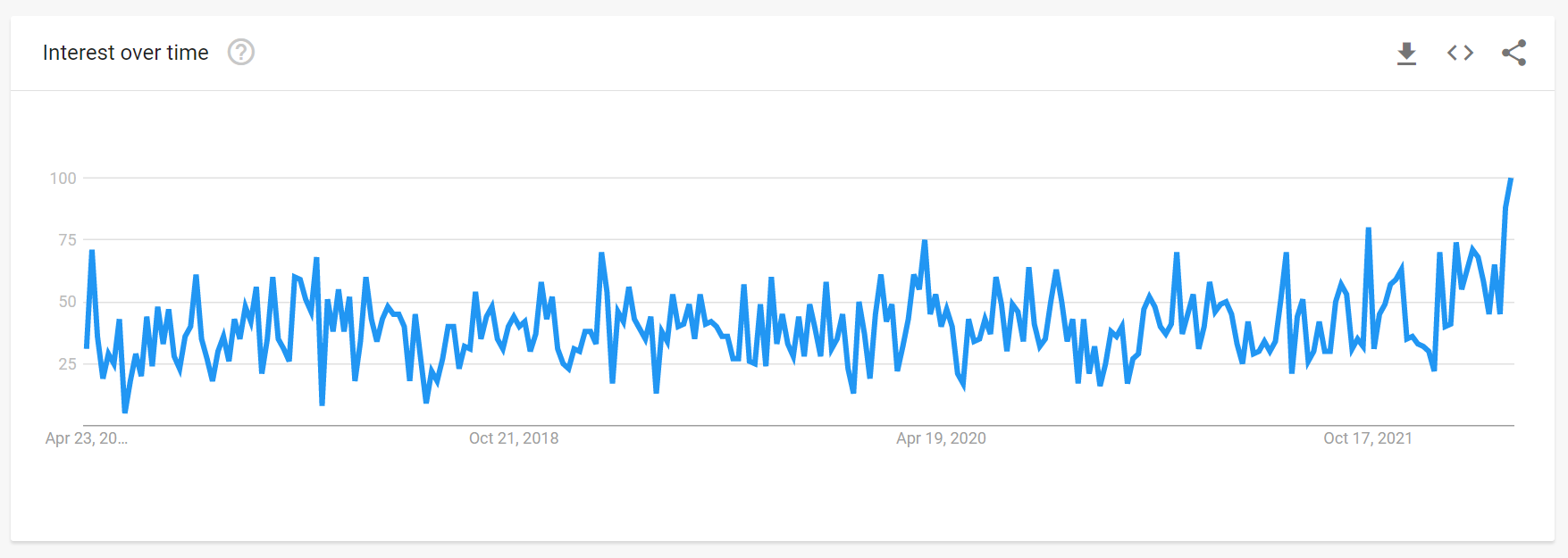
You can change the time period on your Keyword Interest Over Time chart. Above you see I’ve updated my view to 5 years. My goal here is to ensure that intent continues to grow for the terms we are looking at. It’s a red flag if interest drops off or is on a decline. As you can see in the above chart, interest for “content generator” has slowly increased over the last 5 years, with a steady increase in the last year.
Related Searches
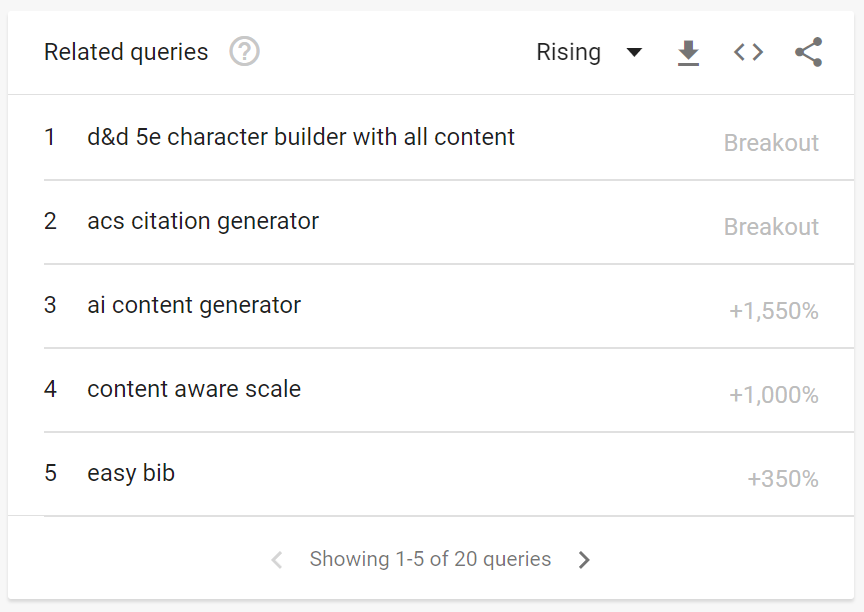
Similar to viewing Related Searches on the SERP itself, the Related Searches view in Google Trends identifies keywords that are growing in popularity. Specifically for AI XYZ, our biggest keyword to note is – “ai content generator” – which is a rising star, up 1550%.
Discover Ranking Keywords and Expand Your Research with Google Search Console
One of the most effective ways to identify keywords for keyword research is by leveraging Google Search Console. This free tool from Google provides a wealth of data about your website’s performance in search engine results pages (SERPs), including the keywords that are driving traffic to your site.
To use Google Search Console for keyword research, start by logging into your account and navigating to the “Search Results” report. This report provides data about the search queries that are driving traffic to your site, including the keywords that users are using when they find your site.
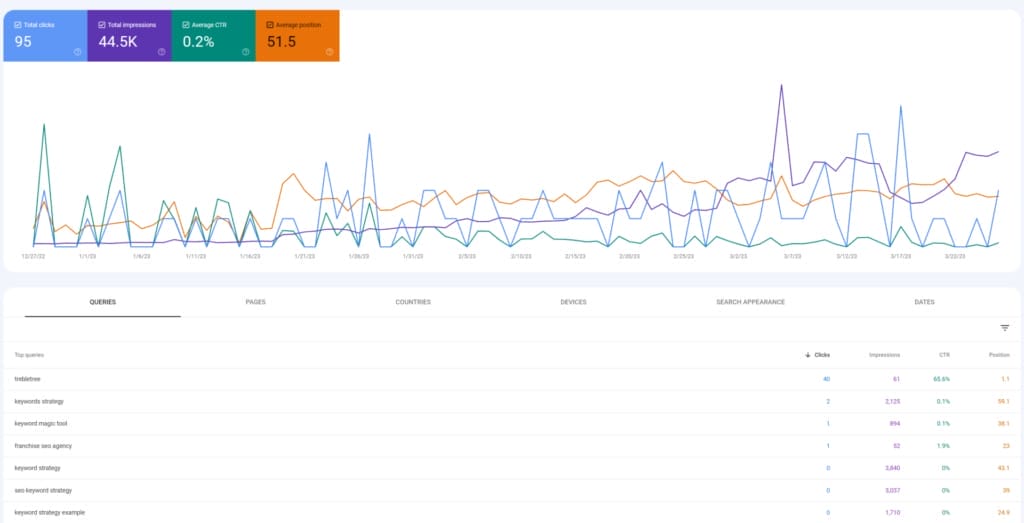
From here, you can identify high-performing keywords that are already driving traffic to your site and incorporate them into your keyword strategy. You can also identify gaps in your keyword strategy and identify new opportunities for content creation and optimization.
Another valuable feature of Google Search Console is its ability to identify long-tail keywords, which are more specific and targeted phrases that can help you reach a more niche audience. By analyzing the queries that users are using to find your site, you can identify long-tail keywords that are relevant to your business and incorporate them into your keyword strategy.
Google Keyword Planner
To use this tool effectively, start by entering a few relevant phrases or keywords related to your business or industry. The Google Keyword Planner will then generate a list of related keywords along with their search volume, competition level, and estimated cost per click. To identify keywords that align with your customers’ search intent, look for those with high search volume and low competition.
You can also use the Keyword Planner to generate ideas for long-tail keywords, which are more specific and targeted phrases that can help you reach a more niche audience. By leveraging the Google Keyword Planner tool to identify relevant keywords, you can create a strong keyword strategy that aligns with your customers’ needs and drives relevant traffic to your website.
SEMRush Keyword Research
SEMRush is an excellent tool for translating search intent into a strong keyword strategy due to its comprehensive keyword research features.
One of its most powerful tools is the Keyword Magic Tool, which allows you to generate keyword ideas based on your target keyword (or input keyword) and provides a range of options for broad match, phrase match, and related keywords.

Keyword Magic Tool – Match Types
Finding relevant keywords using SEMRush requires that you understand it’s core foundation. First, what are the different types of keyword matches?

- Broad match keywords are those that include variations of the target keyword, such as synonyms or related phrases. This type of keyword can help you capture a wider range of relevant traffic and drive more visitors to your site. However, it is important to use these keywords strategically to ensure that they are still relevant to your target audience.
- Phrase match keywords are those that include the target keyword in a specific phrase or combination of words. This type of keyword can help you target a more specific audience and drive more qualified traffic to your site. By including these keywords in your SEO campaign, you can ensure that your content is highly relevant to your target audience and is more likely to convert.
- Exact match keywords include the exact phrase or keyword that you are targeting. This means that the search query must match the exact phrase or keyword in order to trigger your content to appear in the search results. Exact match keywords are highly specific and can be used to target a very specific audience, but they may also result in lower search volume than broad match or phrase match keywords.
- Related keywords are those that are related to the target keyword but may not include the exact phrase. This type of keyword can help you identify new opportunities for growth and expand your reach to a wider audience. By incorporating these keywords into your SEO campaign, you can tap into new data points and drive more traffic to your site.
Keyword Magic Tool – Getting Started
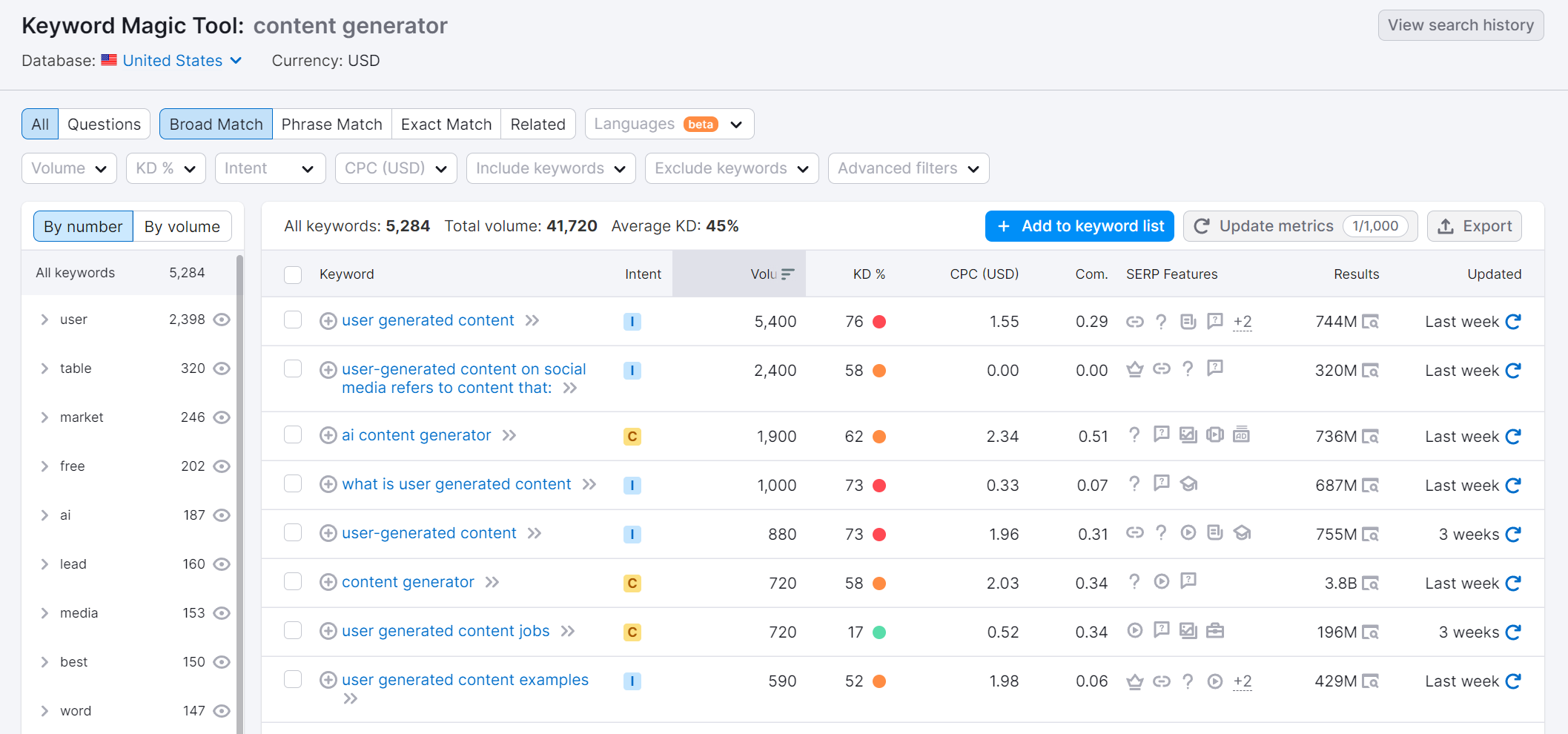
I start with the highest level keyword(s) focusing on what the company does. I call this the seed keyword, as it kicks off our keyword exploration. Enter this into the Keyword Magic Tool. In the example of AI XYZ, my seed keyword is “content generator”.
SEMRush outputs Broad Match keywords first. This is a great list to start finding iterations of your services that customers are searching.
You can easily add keywords to a list to build your keyword list right in SEMRush. As you choose keywords, expand from broad match to phrase match to related to build out a more diverse list for broad ranking potential.
How to Read the SEMRush Keyword Magic Tool Output
- Intent – This is SEMRush’s analysis of the intent of the keyword. I for informational (i.e. looking for more information) and C for commercial (i.e. to make a purchase).
- Volume – Total monthly search volume for the keyword.
- Trend – A quick view of the keyword’s volume trend over the last year.
- KD% – This is a measure of competition. Lower keyword difficulty indicates a keyword that is easier to rank for.
- CPC – Cost per click, specifically used for paid media.
- Com – This is your Competitive Density. It relates to competition in paid search.
- SERP Features – This is a very important piece. It shows you the different features that display on the Search Engine Results Page. This is great to identify if Answer Boxes, Knowledge Panels, or other SERP Features are in place.
- Results – This is the total number of results on the SERP. Simply put, a higher # of results can translate to more competition, but not always.
On the left side of the screen you also have the ability to narrow down your keywords. Now, with the AI XYZ example, we know that what they offer is AI based. So we would find that in the left hand word list and select “ai”. The final output is a series of “ai content generator” terms where the Intent is Commercial. Perfect! This is the target audience we are looking for!
Don’t Forget to Move Past Broad Match Keywords
We’ve identified some great keywords using Broad Match. But as mentioned before – Don’t Stop There! Utilize Phrase Match, Exact Match, and Related keyword tabs to dive into other phrases that our potential customers are using.
In the Phrase Match keyword results shown above, we can see that there are other relevant terms people are searching for that do not include the term “ai” – content generator, blog content generator, content ideas generator, etc. These are all relevant phrases that we will incorporate into our comprehensive keyword strategy.
Further, I dove into the Related searches to find several important high volume keywords – title generator, headline generator, blog title generator. These all represent target keywords with different intent from my original search – but are still very relevant.
TIP: Try toggling between sorting by relevance or “Related %” and Volume %. This will give you a good cross section of both relevance and high volume.
Understanding Competition vs. Monthly Search Volume (MSV)
It’s so important to find that perfect mix between the high volume keywords that drive results and actionable keywords that have lower competition.
High volume, highly competitive keywords will take strong on-page SEO, strong link building, and a domain that has high authority to achieve first page rankings. If you are working with a website that historically has not ranked well or even a website that is just starting out, these may be more challenging to rank for.
On the contrary, moderately competitive keywords that may have lower volumes can provide faster results. This is the beauty of long tail search.
Next Level Keyword Research with Conductor
If you’re looking for an enterprise level suite of SEO keyword tools that can take your keyword research to the next level, Conductor is an excellent choice. This platform provides comprehensive insights into keyword research, competitor analysis, and content optimization, making it an essential tool for any business looking to improve their SEO strategy. By leveraging these tools, you can make informed decisions about your SEO efforts and improve your ranking factors.
Understanding Search Intent at a Granular Level
One of the key features of Conductor’s platform is its ability to understand search intent at a granular level. By analyzing search trends and user behavior, Conductor can provide insights into the specific queries and phrases that users are using when searching for products or services like yours. This can help you develop a more comprehensive keyword strategy that aligns with your customers’ needs and search intent, including keyword modifiers that can help you rank higher for specific queries.
Benefits of Using Conductor for Keyword Research
Here are some of the key benefits of using Conductor for keyword research:
Comprehensive Keyword Research with Conductor Explorer
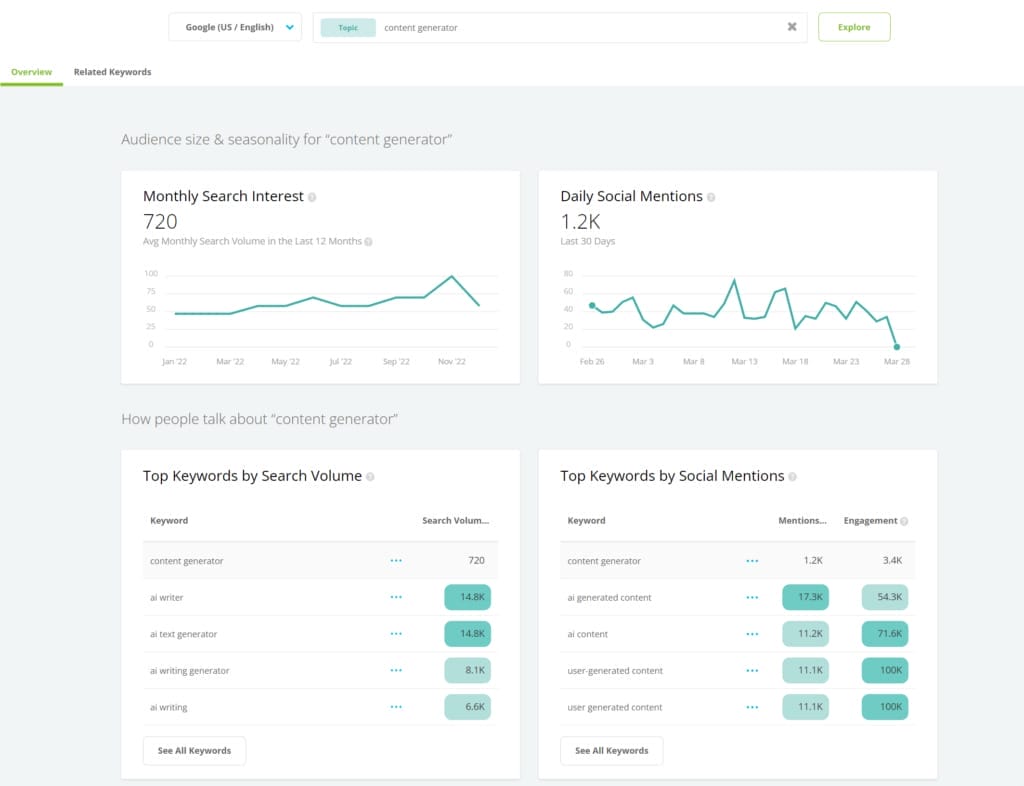
Conductor provides a range of options for identifying relevant keywords, including its Keyword Explorer tool, which allows you to generate keyword ideas based on a seed keyword and provides insights into search volume, competition level, and other relevant data points. This can help you identify topic clusters that are relevant to your business and optimize your content accordingly.
Competitor Analysis via Search Market Share
Conductor’s competitor analysis tools provide detailed insights into your competitors’ keyword strategies, content performance, and backlink profile. This can help you identify gaps in your own strategy and develop a more effective approach to SEO.
Content Optimization Features
Conductor’s Content Mapping tool allows you to map keywords to specific pages on your website, ensuring that your content is highly targeted and relevant to your target audience. Its Content Briefs tool also provides detailed recommendations for optimizing your content for specific keywords and phrases, helping you improve your ranking factors and drive more relevant traffic to your site.
Data Aggregation
Conductor integrates data from a range of sources, including Google Search Console, Google Analytics, and social media platforms, providing a comprehensive view of your SEO performance. This can help you make informed decisions about your SEO efforts and improve your ranking factors over time.
Keep in mind, Conductor is an enterprise SEO tool designed for larger organizations with complex SEO needs. Unlike other SEO tools that are geared towards smaller businesses or individual users, Conductor is specifically tailored to the needs of enterprise-level organizations that require a more robust and comprehensive SEO solution.
The Next Phase of Keyword Research: Topic Clusters for Effective SEO
Up to this point, we’ve identified our customer intent and translated that into actionable keywords. We’ve analyzed their ranking difficulty and competition to understand our long term and quick win opportunities. Next we start creating content. But first, we need to translate our keywords into actionable content briefs. We do so by clustering.
Invaluable Insights of Keyword Clustering
Clustering involves grouping related keywords together based on their semantic relationships. This allows businesses to identify patterns in their customers’ search behavior and create highly targeted content that addresses their specific needs and pain points. By clustering their keywords, businesses can create more effective content that resonates with their target audience and drives more traffic to their website.
For example, let’s say you are a business that sells fitness equipment. By clustering keywords related to different types of equipment (e.g., treadmills, weightlifting equipment, yoga mats), you can create content that speaks directly to customers who are searching for those specific items. This can help you rank higher in search engine results pages (SERPs) and drive more relevant traffic to your website.
Using Surfer SEO for Topic Clusters & Keyword Research
Surfer SEO‘s Cluster Analysis tool is now integrated into its comprehensive Keyword Research tool. It allows us to group related keywords together based on their semantic relationships. This helps us identify the topics that are most important to our clients’ target audience and create content that speaks directly to their needs.
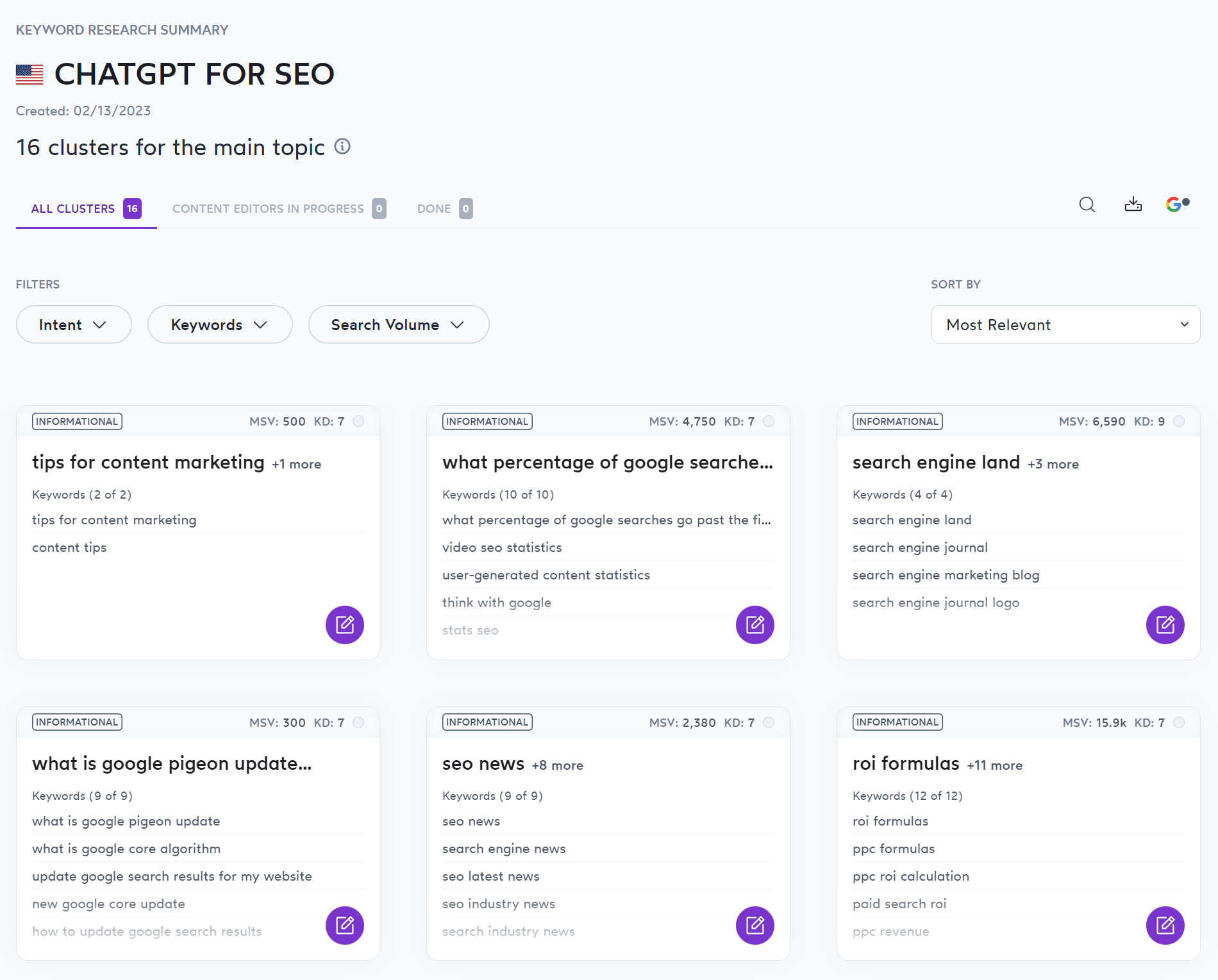
In the example above, we used Surfer SEO to build keyword clusters around the topic of “ChatGPT for SEO”. This groups related keyword together based on overarching topics. This tool makes quick work of identifying unique content opportunities. For example, let’s say one of our clients is a company that sells pet supplies.
Surfer SEO’s Cluster Analysis tool is one of the many AI assisted Surfer SEO tools that Trebletree employs in driving our client’s organic search strategy.
The Importance of Long Tail Keywords
To build a keyword strategy that drives strong search traffic, your keyword set should be diverse. Keywords can be broken into 3 different categories:
- The Head
- The Body
- The Tail

Head Keywords
High Competition, High Volume, Low Conversion
These keywords have high Monthly Search Volumes and drive the highest amount of traffic IF you can rank well for them. However, these keywords are highly competitive.
To rank for a head keyword, it takes a tremendous amount of on-page SEO tactics, backlinks from high authority domains, and having a high authority domain yourself.
If you are optimizing for a brand that is just starting out or one that has not attained a level of authority yet, you will want to start with the Body and the Tail keywords. Once you’ve built up sufficient authority in your space, then move into the more highly competitive Head keywords.
What is Domain Authority?
This is a great opportunity to dig into the term “Domain Authority”. Domain Authority is a measure of the quality of your site, specifically as it relates to sites that link to you. The idea is that if you are a high quality site with high quality content, then high quality sites will link to you. Domain Authority factors in the number of backlinks you have, the quality of the sites you are getting backlinks from, social signals, your content’s quality, and even overall SEO performance.
Body Keywords
Moderate Competition, Medium Volume, Moderate Conversion
These are the terms that make up the middle of your keyword strategy. They have moderate competition, moderate volume, and even moderate conversion rates. Create content around Body keywords – through top level pages or blog post pages – and you can see significant results.
Long Tail Keywords
Low Competition, Low Volume, High Conversion
Long Tail Keywords are the sweet spot for any SEO. Hidden behind low search volume, long tail keywords can be a traffic monster. And with lower competition making their keyword difficulty low, success with long tail keywords is attainable even for new domains.
Long Tail Keywords represent all of the keywords with lower search volume and longer phrases. They represent a more natural way of searching – bringing us back to the importance of customer intent. While a single long tail keyword may not provide significant search volume by itself, it is just one of many different ways of writing that particular form of intent.
As voice search becomes more prevelant and search queries are based on our natural way of speaking, the significance of long tail keywords is growing.
If you have one blog post that ranks in position 1 for 20 long tail search keywords, each with an MSV of 50 – that’s 1,000 searches who will be exposed to your site first.
Don’t let phrases like “low competition” or “low volume” fool you. Customers with more detailed search queries are often more likely to convert. And, there are a larger number of keywords you can hit with a single piece of content. This makes long tail keywords an incredible successful piece of your keyword strategy.
Long Tail Keywords – Search Example
Let’s look at our AI XYZ and the long tail term – “blog content generator”.
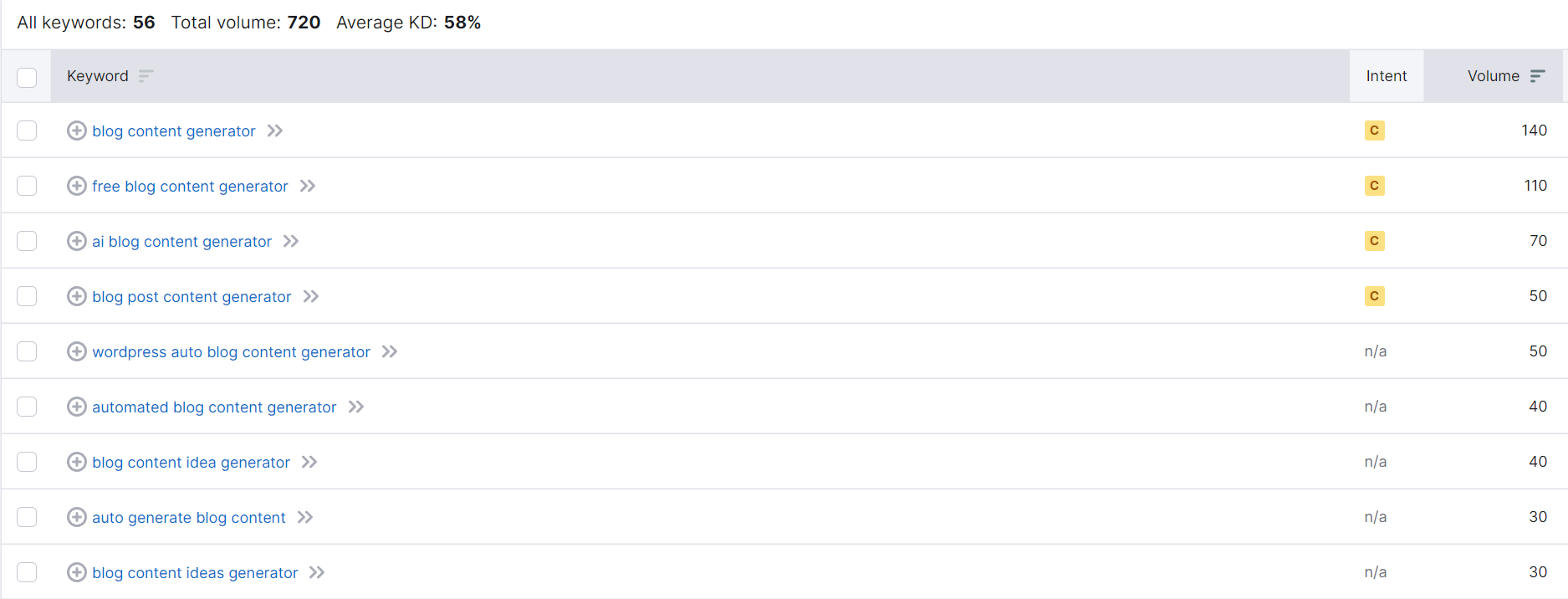
If we create content around the assortment of long tail keywords outlined in the keyword list above, we’re looking at a target audience size of 560. And these just represent the first 9 top terms.
Building a Lasting Keyword Strategy
Now it’s time to pull it all together. Let’s break off those training wheels and hit the road!
If you followed our keyword research steps outlined above, you’ll have the following:
- A brainstorm output of customer intent
- A list of topics vetted by Google Trends
- Insights from your competitors by analyzing the SERP
- Broad Match, Phrase Match, and Related Searches from the SEMRush Keyword Magic Tool that cover Head, Body, and Long Tail Keywords
This is a lot of data to bring together. Now how do you compile this into a cohesive keyword strategy?
Unfortunately this is where I say that it comes down to expertise and experience. In most cases we are compiling a combination of head, body, and long tail keyword terms to create a holistic keyword strategy that is both immediately actionable and provides long term goals.
Have More Questions on Keyword Strategy?
If you are a brand looking for keyword strategy support, we’ve got you covered. Even if you are an SEO just looking to network with other SEOs passionate about keyword strategy. Drop us a line and let us know what questions you have.




